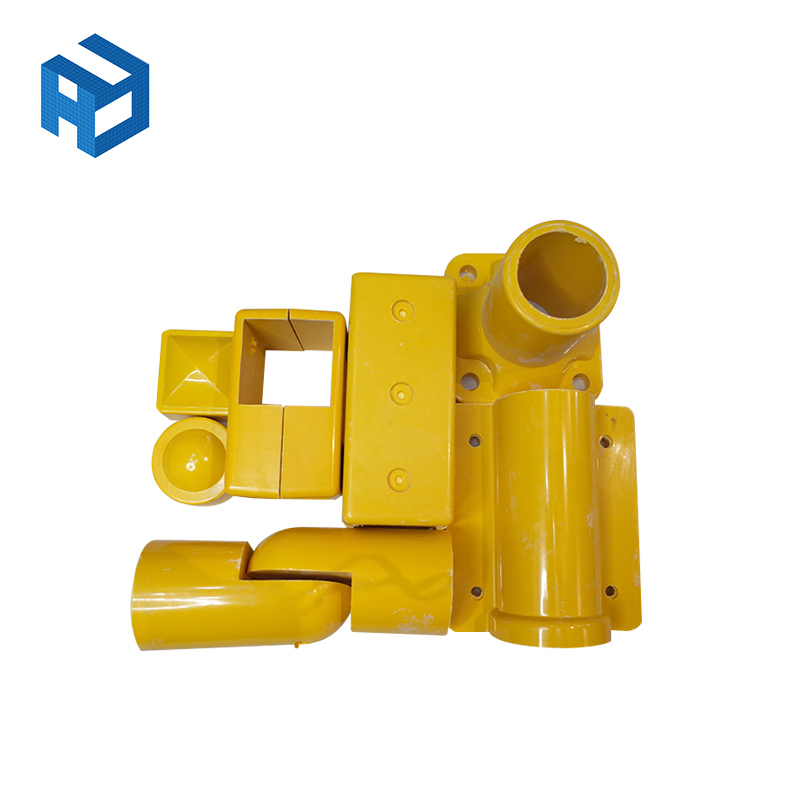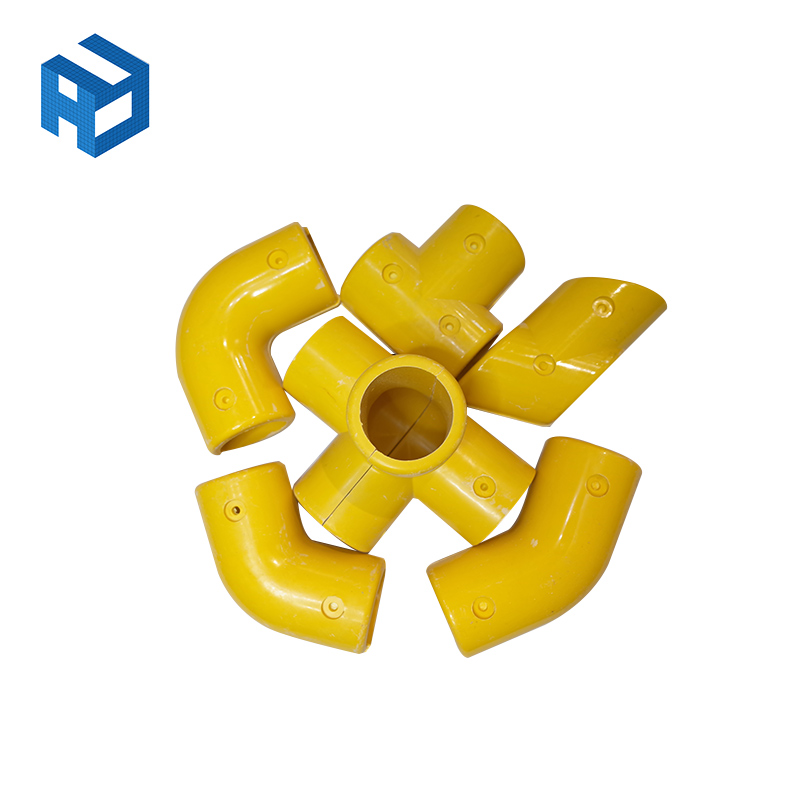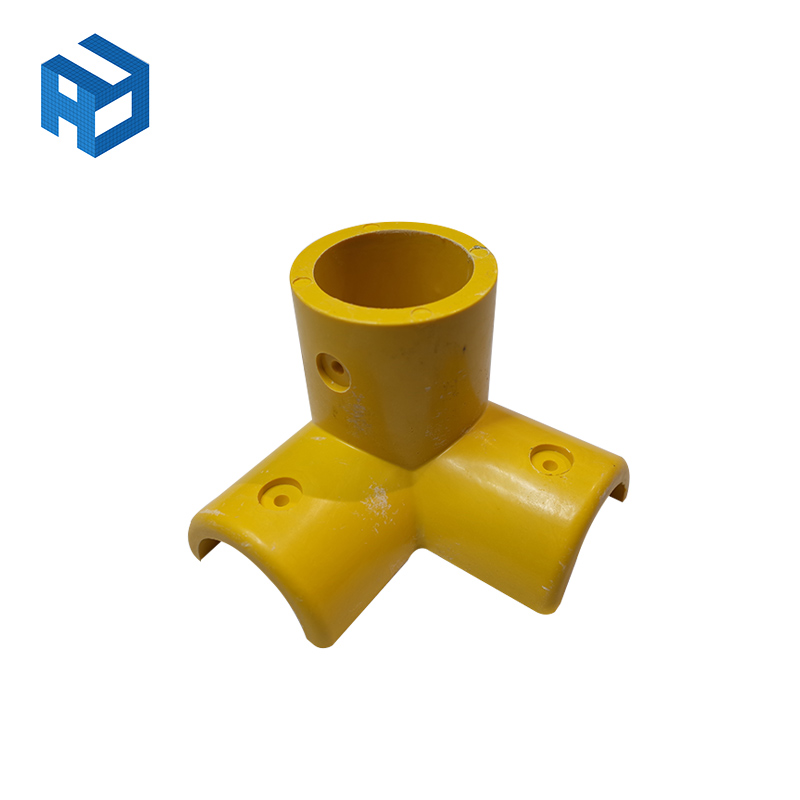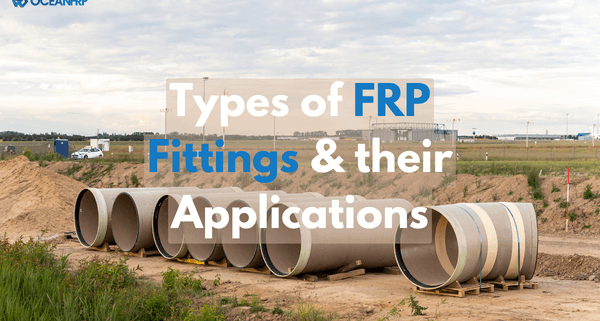Types of FRP Fitting and Their Applications
Fiberglass-reinforced plastic (FRP) fittings are essential in various industries due to their superior corrosion and chemical resistance. These fittings are crucial links within FRP piping systems, ensuring materials’ structural integrity and efficient flow. Utilized across the United States and globally, FRP fittings are favored for their strength-to-weight ratio and durability, contributing to an extended service life.
FRP fittings are engineered to withstand harsh environments where traditional steel pipes may corrode, making them ideal for process piping in chemical plants, power plants, and wastewater treatment facilities. Their design often incorporates a corrosion barrier, structural layer, and resin system, including vinyl ester or epoxy, enhancing their mechanical properties and operating temperature range. In this post, we’ll discuss the types of FRP fittings and their applications.
FRP Fittings Overview

FRP fittings are a group of pipe fittings manufactured from fiberglass-reinforced plastic, a composite material known for its lightweight and alkali-resistant properties. These fittings are designed to connect sections of FRP pipes, forming a leak-proof and resilient network capable of handling various media. The diverse range of FRP fittings includes standard shapes and custom configurations to suit the unique demands of each application.
The design of FRP gratings, such as the filament wound laminate or the chopped strand mat, contributes to their tensile strength and ability to accommodate thermal expansion. Material and resin selection is tailored to the application’s needs, ensuring each fitting performs optimally under the expected conditions, including exposure to aggressive chemicals or extreme temperatures.
FRP fittings offer superior corrosion resistance compared to steel piping, significantly enhancing their design life. This is particularly beneficial in environments where steel or carbon steel may degrade quickly. Furthermore, including components such as woven roving and glass fiber enhances the structural shapes, ensuring they maintain their integrity even under axial loads.
Types of FRP Fittings
FRP fittings encompass various shapes and sizes, including wye connections, elbows, tees, couplings, reducers, crosses, flanges, adapters, unions, and bends. Each is designed to fulfill a specific function within FRP piping systems, from changing the flow direction to connecting pipes of different diameters. With their corrosion-resistant nature and glass-fiber reinforced construction, these fittings are pivotal in maintaining continuous and efficient operations in various industrial settings.
Wye Connections
Wye connections are specialized pipe fittings that create a branch line at a 45-degree angle from the main FRP pipe. This design reduces friction and turbulence in the flow of fluids or gases, thereby maintaining system efficiency. Wye connections are used extensively in residential and industrial plumbing, sewer, and waste management systems.
Elbow
Elbows are curved pipe fittings that enable FRP pipes to turn corners or change direction. They come in various angles, the most common being 45-degree and 90-degree turns. Elbows are crucial in systems where space is limited and a straight run of pipe is impossible, ensuring that pipelines can be routed around obstacles while minimizing pressure loss.
Tees
Tees are T-shaped pipe fittings that join three sections of FRP pipes. Their main function is to split a flow into two directions or combine two flows into one. They are indispensable in applications where multiple fluid streams are manipulated, such as in water distribution networks or chemical processing systems.
Coupling
Couplings are pipe fittings that connect two pieces of FRP pipe. These simple but essential fittings extend the length of a pipe run or repair a broken or leaking section. They come in various types, including flexible couplings that accommodate minor misalignments and rigid couplings for a firm connection.
Reducer
Reducers are pipe fittings that connect two FRP pipes of different diameters, allowing a smooth transition between sizes. They are vital in systems requiring a change in the flow rate or pressure of the conveyed material. Reducers help maintain an optimal flow velocity, preventing erosion or cavitation.
Crosses
Crosses are four-way pipe fittings that create a junction point where FRP pipes from four different directions converge or diverge. They are less common than tees but are used in specialized applications where multiple fluid streams need to intersect, such as intricate process piping networks.
Flange
Flanges are circular pipe fittings that connect FRP pipes to other components, such as valves or pumps, or join two sections of pipe together. They are designed with a flat surface that can be bolted together, creating a secure and accessible joint that can be easily disassembled for maintenance or inspection.
Adapter
Adapters are pipe fittings that facilitate the connection of FRP pipes to dissimilar materials or different piping systems. They are critical in transitions where a change in diameter, thread type, or pipe material occurs, ensuring compatibility and a leak-proof seal between the different sections.
Union
Unions are pipe fittings that allow for the quick disconnection and reconnection of FRP pipes without cutting. Like flanges, unions consist of three components: a nut, a female, and a male end. They are particularly useful in piping systems requiring frequent cleaning or maintenance disassembly.
Bend
Bends are fittings that facilitate directional change in FRP piping systems. They are similar to elbows but have a smoother, more gradual curvature, which allows for less turbulent flow and reduced pressure drop. Bends are commonly used in applications where space allows for a wider turn radius, optimizing flow dynamics.
Features of FRP Fittings

FRP fittings are renowned for their robust mechanical properties, including high tensile strength, corrosion and chemical damage resistance. These characteristics make them suitable for various demanding applications, ensuring the safe and efficient transport of fluids and gasses.
Durable and High-Strength
FRP fittings are engineered for longevity and high performance. The combination of glass-fiber reinforced thermosetting resin and strategic material and resin selection results in durable and strong products. This durability is critical to maintaining the integrity of FRP flat panels over time, even in the face of corrosive chemicals and variable temperatures.
Corrosion Resistant
FRP fittings, crafted using the filament winding process, are renowned for their exceptional corrosion resistance. Unlike carbon steel, FRP pipes do not succumb to the deteriorative effects of harsh chemicals. This inherent corrosion resistance significantly extends the service life of FRP equipment, making it a cost-effective choice for many industries.
Lightweight and Easy to Install
The lightweight nature of FRP fittings greatly simplifies handling and installation processes. Workers can easily maneuver and fit these components without heavy lifting equipment, reducing installation costs. Their lightness, combined with their robustness, makes them an attractive alternative to traditional materials.
Easy Installation and Customization
Fiberglass pipe fittings are easy to install and can be customized to meet the demands of various applications. For example, the ability to create a long-term chlorine header solution showcases the versatility and adaptability of FRP pultruded profile in complex installations and corrosive environments.
Applications of FRP Fittings
Due to their durability and corrosion resistance, FRP fittings have various applications across diverse industries. They serve critical infrastructure, processing, and utilities functions, demonstrating adaptability and reliability in various environments.

FRP Pedestrian Bridges
FRP fittings are an excellent choice for pedestrian bridges. They offer abrasion resistance and the ability to withstand environmental elements. Their durability ensures a long-lasting structure, which is especially beneficial for high-traffic areas.
Wastewater and Water Treatment
FRP fittings are indispensable in wastewater and water treatment facilities. They resist the corrosive effects of treatment chemicals and provide a durable solution for piping systems essential to these operations.
Military
The military relies on FRP fittings for their robustness and corrosion resistance. These characteristics are crucial in demanding environments where equipment reliability and longevity are of the utmost importance.
Cooling Towers
FRP fittings find extensive use in cooling towers, where their resistance to moisture and chemicals ensures efficient operation and a reduced need for maintenance.
Oil and Gas
The oil and gas industry benefits from using FRP fittings. These fittings withstand the corrosive substances encountered in extraction and processing, ensuring safe and continuous operations.
Plant and Chemical Processing
Chemical processing plants utilize FRP fittings to maintain the integrity of their systems in the presence of aggressive chemicals, thereby safeguarding against leaks and potential hazards.
Utilities
Utility providers incorporate FRP fittings into their systems because they are long-lasting and resistant to environmental stress, ensuring reliable service to the community.
Mining
Mining operations favor FRP fittings because they are strong and resistant to the corrosive and abrasive materials often found in the process.
Agricultural
Agricultural industries use FRP fittings for irrigation and water management systems, benefiting from their resistance to various elements and longevity.
Architectural
Architecturally, FRP fittings contribute to a design’s aesthetic and functional aspects, offering creative solutions that are both durable and resistant to weathering. FRP grating platforms and handrails have a variety of applications in the architectural sector.
Golf Courses
FRP fittings are utilized in golf course maintenance, particularly in water features and irrigation systems, providing a low-maintenance, rust-free solution to landscaping needs.
Theme and Water Parks
FRP fittings are sought after in theme parks and water parks for their ability to withstand harsh chemical exposures and constant water contact. They are used in applications such as water slide constructions, splash pads, and piping systems for water rides. Their lightweight nature simplifies the installation process in the intricate designs of theme park attractions, ensuring a safe and durable infrastructure for visitors to enjoy.
Pulp and Paper
The pulp and paper industry benefits from FRP fittings due to their resistance to corrosion and ability to handle various chemicals used in the paper production process. These fittings are used in pipelines that transport caustic and acidic fluids, where traditional materials would deteriorate quickly. The durability of FRP ensures a longer lifespan for the systems and a reduction in maintenance costs, making them an economical choice for the industry.
Wrap-Up!
In conclusion, the variety of available FRP fittings provides engineers and designers with the tools to create efficient and resilient systems for many applications. From custom corrosion solutions in harsh chemical environments to utilizing standard FRP pipe configurations for water treatment facilities, the adaptability of FRP fittings ensures they meet the demands of various industries. Their inherent characteristics, such as durability and resistance to corrosion, make them a reliable choice for long-term installations.
The versatility of FRP fittings is evident in their widespread use across diverse sectors. Whether it’s reinforcing the infrastructure of a golf course or ensuring the safe transport of substances in a chemical processing plant, FRP fittings play an essential role. Acknowledging the significance of FRP fittings in modern construction and maintenance projects is pivotal for any industry looking to enhance efficiency and reduce maintenance costs over time.



